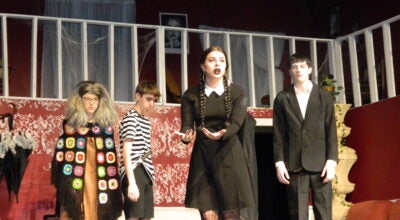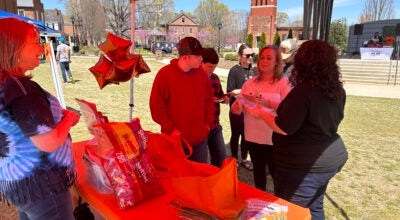In Brazil, a Catawba student joins national protest
Published 12:00 am Monday, June 24, 2013
CAMPINAS, BRAZIL — Following the final exam of sophomore year at Catawba College, Heitor Vinci boarded a plane last month for his home country of Brazil. A month later he found himself marching along with tens of thousands as the country erupted into mass civil unrest.
Vinci was one of an estimated one million protestors who flooded the streets of Brazil’s largest cities on Thursday asking for an end to government corruption, excessive taxes and frivolous public spending.
In his hometown of Campinas, the 20-year-old business administration major walked along with a dozen friends as signs, songs and chants filled the city. Campinas had about 70,000 protestors, Vinci said.
“The protests and manifestations will continue ‘til we see changes in the government,” Vinci told the Post through a series of emails. “The atmosphere is awesome. Everybody sings the national anthem and holds posters up with constructive messages.”
The swell of participants garnered international attention last week as what began as a peaceful protest quickly exploded into pockets of violence.
In the city of Belo Horizonte, police used tear gas and rubber bullets on protestors who tried to pass through a barrier and threw rocks at a car dealership, according to the Associated Press.
Vinci said he saw a brief outburst of violence during his march in Campinas, but said majority of protestors stressed the need for peaceful protests. He estimated about 30 in the group of violent demonstrators.
“I saw the police acting, but not against everybody,” Vinci said, “the police only acted once some of the protestors started throwing rocks against the government building, and also when they started trying to invade the building to damage public property. In my eyes, in this particular protest, the police acted right, they didn’t overreact once. Not what we’ve seen in other cities in Brazil, where the police overreacts, attacks journalists and cameramen trying to cover the streets.”
Born in Brazil, Vinci moved to America to study in a Florida boarding school when he turned 16.
He later accepted an academic and athletic scholarship to play soccer at Catawba College.
“My family still lives in Brazil and for this reason I still come home very often,” Vinci said. “I joined the protest because the Brazilian population is (asking) for better education, health, management of public money, less corruption and excessive taxes.”
Vinci, like many Brazilians, he said, have a general distrust for the local media who he claims is heavily influenced by the government.
He and friends created Facebook events for the protests and invited friends and neighbors to join in the demonstrations.
“I feel great participating in one of the biggest manifestations my country has ever seen. We are writing history,” Vinci said. “We are no longer sitting on the couch waiting on someone else to do the job. This new “Facebook generation” decided to use this new social networking era for something useful. I feel like social networking was the main tool that spread and shared all kinds of information without government or media censure.”
At least one poll shows Brazilians are overwhelmingly in favor of the protests.
The weekly magazine Epoca found 75 percent of a sample group from around the country were in favor of the demonstrations.
Protests continued again Saturday with another quarter-million Brazilians taking to the streets.
The Globo TV network reported Sunday that President Dilma Rousseff’s administration is expected to announce its first response to the protests on Tuesday, according to the AP. The response is expected to address additional funds for a health care program that could train more doctors.
Despite low unemployment numbers, Brazilians are facing an uptick in inflation and a high cost of living.
Heavy spending on the Confederations Cup and next year’s World Cup has also exacerbated the frustration for Brazilians who pay more taxes than any nation outside of the developing world — 36 percent of the gross domestic product.
In Campinas, Vinci said, residents of all ages — some clad in Guy Fawkes’ masks — chanted the national anthem.
The mask, which is best known for its symbolism in the film, V for Vendetta, was meant, in part, to gather support for the local populace, Vinci said.
“Some of the protestors were wearing the ‘V’ mask to represent the power of the people, the power of the population,” Vinci said.
Most of the Campinas protestors were between 17 and 25, Vinci said, but ages ranged into the mid-60s.
“I remember some of the signs saying, ‘We want justice.’ Most of the signs claimed for end of corruption, better education and better health. A lot of the signs said, ‘Come to the streets,’ ” he recalled.
Some residents were afraid, Vinci said, but others, including his friends, painted themselves in various colors to show their support.
“There were a couple people who didn’t come out. Like I said before, the images are very powerful. When the police shoots rubber bullets and throws gas bombs, violence is the first thing that comes to our mind,” he said.
But most protestors want peaceful demonstrations, he said, and some even chanted “No violence” during the trek.
Vinci said he will return to Salisbury in two weeks and doesn’t expect to protest again before that, despite another major protest slated for July 1.
“To me, our biggest challenge right now is to separate the honest people, the protestors who are there to manifest their rights peacefully from the ones who are breaking public property, setting buses on fire and even looting shops during manifestations,” Vinci said. “Brazil is an emerging country with a lot of class division. We have a long way to go.”
Contact reporter Nathan Hardin at 704-797-4246.




